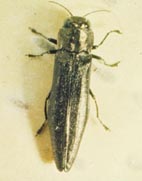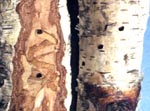Bronze Birch Borer
Agrilus anxius
Description
The bronze birch borer is a greenish-bronze beetle 1/4 to 1/2 inch long with a rather blunt head and a slender pointed body. The larvae are slender white grubs about 3/4 of an inch long and have a slight brownish enlargement of the body just behind the head.

Figure 1. Bronze Birch
Borer Adult
Life History
In May and June, the adult female lays tiny white eggs, one at a time, either in cracks in the bark or in crevices made by her jaws. The eggs hatch in about 10 days, and the larvae bore into the bark. The larvae remain active until fall, forming burrows 4 or 5 feet long. The burrows are very crooked and are filled with frass. They cross and recross, often completely cutting off the circulation of the sap. The larvae overwinter in cells constructed at the end of the tunnels. The following spring, the larvae pupate and emerge as adults through small D-shaped holes about 1/8 inch in diameter that are cut in the bark. There is only one generation a year.

Figure 2. Bronze Birch
Borer Damage to Birch
Damage
The injury to birch is caused by the larvae tunneling just under the bark. This tunneling creates feeding galleries that, in effect, girdle the trunk or branch. The initial result is a yellowing and thinning of the leaves in the upper crown. If not checked, the infestation gradually will move downward. In addition, adventitious growth develops in the lower crown occasionally, causing twigs to die back in the upper crown. This is followed by the death of the entire tree.
Visual Signs Of An Infestation
- A yellowing and thinning of leaves in the upper crown.
- Raised bumps and D-shaped holes on upper limbs and the trunk.
- The presence of galleries and tunnels just under the bark.
- Dead and broken branches in the upper crown.
Nonchemical Control
Prevention is the key in preventing borer infestations. Keep plant material healthy and vigorous by proper watering, mulching, and fertilizing. The whitespire birch, river birch, and Heritage birch appear to be less susceptible to borer attacks.
Chemical Control
Insecticidal sprays may be applied in early summer when adults are emerging with a repeat spray three weeks later